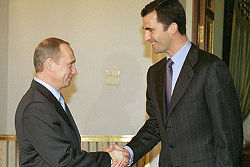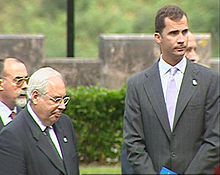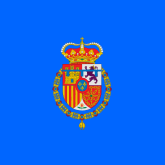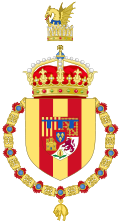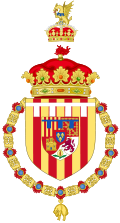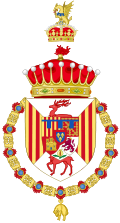- Felipe, Prince of Asturias
-
Felipe Prince of Asturias 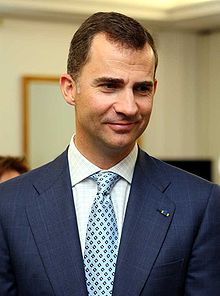
Spouse Letizia, Princess of Asturias Issue Infanta Leonor of Spain
Infanta Sofía of SpainFull name Philip John Paul Alphonse of All Saints
Spanish: Felipe Juan Pablo Alfonso de Todos los SantosHouse House of Bourbon[1][2] Father Juan Carlos I of Spain Mother Sophia of Greece and Denmark Born 30 January 1968
Madrid, SpainReligion Roman Catholicism Felipe, Prince of Asturias (Spanish pronunciation: [feˈlipe], baptised as Felipe Juan Pablo Alfonso de Todos los Santos (et omnes sancti) de Borbón y de Grecia; born 30 January 1968), is the third child and only son of King Juan Carlos and Queen Sofía of Spain.
As heir apparent to the Spanish throne he bears the official titles of Prince of Asturias, Prince of Girona, Prince of Viana, Duke of Montblanc, Count of Cervera and Lord of Balaguer.
Contents
Birth and early life
Felipe was born in Madrid. His birth, after that of his two sisters, the infantas Elena and Cristina, ensured a male successor to the Spanish throne. His full name is Felipe Juan Pablo Alfonso de Todos los Santos de Borbón y de Grecia. The symbolic names given at his christening, by the Archbishop of Madrid Casimiro Morcillo González included the names of the first Bourbon to reign in Spain; his grandfathers (Infante Juan, Count of Barcelona and Paul of Greece); his great-grandfather King Alfonso XIII of Spain; and All Saints (Todos los Santos or et omnes sancti) as is customary among the Bourbons. At the time of his birth he was titled as Infante of Spain, as his father was not yet King and Felipe was not yet heir apparent. His godparents were his grandfather Infante Juan, Count of Barcelona and his great-grandmother Queen Victoria Eugenia.
On 30 January 1986, at the age of 18, Felipe swore allegiance to the Constitution and to the King in the Spanish Parliament, fully accepting his institutional role as successor to the Crown.
Activities in Spain and abroad
Felipe started school at Santa Maria de los Rosales, a modern day school where he could fit in without special treatment. Felipe attended high school at Lakefield College School in Ontario, Canada, and studied in the Autonomous University of Madrid, where he earned a degree in Law. He also completed several courses on economics. He completed his academic studies by obtaining a Master of Science in Foreign Service degree from the Edmund A. Walsh School of Foreign Service at Georgetown University, where he was the roommate of his cousin, Crown Prince Pavlos of Greece. Felipe has fulfilled his institutional commitments in his capacity as Heir to the Crown, chaired many official events in Spain, and participated in key events in different sectors and aspects of Spanish public life. Since October 1995, Felipe has made a series of official visits to the Spanish Autonomous Communities with a view to gaining in-depth knowledge of Spain and making contact with other Spaniards. Felipe holds regular meetings with constitutional bodies and the main state institutions in order to keep in touch with their activities. He also attends meetings of the various bodies of the Central Administration and of the Autonomous Communities as required by his national and international institutional activities. Felipe grants public and private audiences to a large number of people with a view to receiving up-to-date information on national and international affairs. In particular, he holds meetings with people close to his own generation with outstanding careers in political, economic, cultural and media circles. When King Juan Carlos is unable to attend, Felipe presides over the annual presentation of dispatches to Officers and Non-Commissioned Officers of the Armed Forces and participates in military exercises held by the three services.
Spanish Royal Family - HRH The Prince of Asturias
HRH The Princess of Asturias - HRH The Duchess of Lugo
- HRH The Duchess of Palma de Mallorca
HE The Duke of Palma de Mallorca
Extended royal familyHe has made many official visits to European countries and to Latin America, as well as to countries in the Arab world, the Far East, and Australia. He shows special interest in all matters related to the European Union, the Middle East, North Africa, and Latin America. Since January 1996, Felipe has represented the Spanish State at the swearing-in ceremonies for several Latin American Presidents. Felipe has also played a very active role in the promotion of Spain's economic and commercial interests and of Spanish language and culture in foreign countries. He frequently presides at economic and trade fairs held by Spain abroad (Expotecnia, Expoconsumo, and Expohabitat), and is especially interested in promoting the creation of Centres and University Chairs to disseminate the history and current situation of Spain in major foreign universities. Felipe is godfather to at least four children: Luis Felipe Gómez-Acebo y Ponte, the son of his cousin, Beltrán (son of Infanta Pilar); Princess Ingrid Alexandra of Norway, daughter of Haakon, Crown Prince of Norway; Prince Vincent of Denmark, second son of Frederik, Crown Prince of Denmark, and Princess Sofia of Bulgaria, daughter of Prince Konstantin of Bulgaria. In turn, Konstantin is godfather to Felipe's daughter, Sofía.
Gregarious and outgoing, Felipe speaks Spanish, Catalan, French, English and some Greek.[3]
Participation in the Olympics
Felipe was a member of the Olympic sailing team at the Barcelona Games in 1992, which recalled his mother's and uncle's position on the Greek sailing team in 1960. He also took part in the opening ceremony as the Spanish team's flag bearer. He finished in sixth position in the Soling class and obtained an Olympic Diploma.
Marriage and children
The bachelorhood of Felipe was an issue in the Spanish press for several years. His name was linked with several eligible women, but only two with any conviction: Spanish noblewoman Isabel Sartorius, who was not viewed favorably by the Royal Family due to her being three years older than he was and having divorced parents;[citation needed] and Norwegian model Eva Sannum, who had modeled underwear, something favored by neither the Spanish people nor the Royal Family.[citation needed] When Felipe finally began a serious relationship, nothing was suspected before the official announcement. On 1 November 2003 the Prince's engagement to Letizia Ortiz Rocasolano, an award-winning television journalist formerly with CNN, was proclaimed. Despite the fact she had been civilly married and then divorced, the public generally approved of Letizia since she represented the modern woman—independent, cultured, and accomplished in her profession. The couple married on the morning of 22 May 2004 in the Almudena Cathedral in Madrid, with members of several European royal families attending. Ortiz had previously been married to Alonso Guerrero, a teacher and author; they were divorced in 1999. The wedding was watched by more than 25 million television viewers in Spain alone, and was broadcast throughout the world. Letizia Ortiz then gained the title HRH The Princess of Asturias, but is often referred to as Princess Letizia. On 8 May 2005, the Spanish Royal House announced that the couple were expecting their first child in November.
- HRH Infanta Leonor de Todos los Santos of Spain, was born on 31 October 2005 at 2.35 am weighing 3500 grams and measuring 47 cm. She is the second in the succession to King Juan Carlos after Prince Felipe.
On 25 September 2006, the Royal House announced that the couple were expecting their second baby in May 2007.[4] On 28 November 2006, it was revealed that the child would be a girl.[5]
- HRH Infanta Sofía de Todos los Santos of Spain was born on 29 April 2007 at 16.50 pm weighing 3100 grams and measuring 50 cm. She is the third in the succession to King Juan Carlos after her father and older sister.
Public protest
After the 11 March 2004, Madrid bombings, Felipe, along with his sisters Elena and Cristina, became the first members of the Spanish royal family ever to take part in a public protest.
Social work
In addition to his official activities, Felipe is Honorary President of several associations and foundations , such as the Imperial Munitions Board, which finances specific economic and social development activities in Ibero-America and other countries, and the Spanish branch of the Association of European Journalists, which is composed of outstanding communications professionals. Most noteworthy is the Príncipe de Asturias Foundation, where he presides annually the Awards ceremony of these highly prestigious Awards, at the international level, that carry his name.
Within the framework of these institutions which work towards aims of general interest, Felipe focuses his interest on activities in the fields of development projects, voluntary work, the environment, universities, the integration of young people in the workplace and business, relations between business circles and society and social communication.
On the occasion of the United Nations declaration of 2001 as the International Year of Volunteers, the UN Secretary General, Kofi Annan, named Felipe an "Eminent Person" so that he could contribute on an international level towards enhancing the importance of voluntary workers.
Titles, styles, honours and arms
Titles and styles
Main article: List of titles and honours of Felipe, Prince of AsturiasRoyal styles of
The Prince of Asturias
Reference style His Royal Highness Spoken style Your Royal Highness Alternative style Sir - 30 January 1968 – 22 January 1977: His Royal Highness The Infante Felipe of Spain
- 22 January 1977 – present: His Royal Highness The Prince of Asturias
- in Catalonia: 22 January 1977 – present: His Royal Highness The Prince of Girona
- in Navarre: 22 January 1977 – present: His Royal Highness The Prince of Viana
When Felipe was born, his father did not have any official title or post in Spain, but he was registered in the Civil Registry as Infante, with the style of Royal Highness. About a year after his birth, General Franco recognized Juan Carlos as successor to the Headship of State and bestowed him the title of Prince of Spain. Thus, Felipe became second-in-line in the line of succession to the vacant throne. Juan Carlos became King in 1975, but no title was conferred to Felipe as heir apparent until 2 January 1977, when he was created Prince of Asturias, the title normally held by the heir to the Spanish throne, by a Royal Decree which also entitled him to use "the other historical titles corresponding to the heir of the Crown".[6]
Rarely used, the Prince's style and title in full is: His Royal Highness the Most Serene Infante Don Felipe Juan Pablo Alfonso de Todos los Santos de Borbón y Grecia, Prince of Asturias, Girona and Viana, Duke of Montblanc, Count of Cervera and Lord of Balaguer. Although legally warranted since 1977, Felipe started to use in public the Aragonese-Catalan title of Prince of Girona on 21 April 1990, during a trip around Aragon, Catalonia and Valencia, becoming the first Bourbon to use this title.[7] Later, he did the same thing with the Princedom of Viana in Navarre, and the titles of Duke of Montblanc, Count of Cervera and Lord of Balaguer in their appropriate places. If Prince Felipe succeeds to the throne and uses his first given name as his regnal name, he would be known as Philip VI.
Military ranks
 1 August 1985 – 7 July 1986: Officer Cadet, Spanish Army[8]
1 August 1985 – 7 July 1986: Officer Cadet, Spanish Army[8] 7 July 1986 – 7 July 1989: Cadet 2nd Lieutenant, Spanish Army[9]
7 July 1986 – 7 July 1989: Cadet 2nd Lieutenant, Spanish Army[9] 10 July 1986 – 7 July 1989: Midshipman, Spanish Navy[10]
10 July 1986 – 7 July 1989: Midshipman, Spanish Navy[10] 10 July 1987 – 7 July 1989: Cadet 2nd Lieutenant, Spanish Air Force[11]
10 July 1987 – 7 July 1989: Cadet 2nd Lieutenant, Spanish Air Force[11] 7 July 1989 – 1 December 2000: Lieutenant, Spanish Army[12]
7 July 1989 – 1 December 2000: Lieutenant, Spanish Army[12] 7 July 1989 – 1 December 2000: Ensign, Spanish Navy[13]
7 July 1989 – 1 December 2000: Ensign, Spanish Navy[13] 7 July 1989 – 1 December 2000: Lieutenant, Spanish Air Force[14]
7 July 1989 – 1 December 2000: Lieutenant, Spanish Air Force[14] 1 December 2000 – 3 July 2009: Commandant, Spanish Army[15]
1 December 2000 – 3 July 2009: Commandant, Spanish Army[15] 1 December 2000 – 3 July 2009: Corvette Captain, Spanish Navy[15]
1 December 2000 – 3 July 2009: Corvette Captain, Spanish Navy[15] 1 December 2000 – 3 July 2009: Commandant, Spanish Air Force[15]
1 December 2000 – 3 July 2009: Commandant, Spanish Air Force[15] 3 July 2009 – present: Lieutenant Colonel, Spanish Army[16]
3 July 2009 – present: Lieutenant Colonel, Spanish Army[16] 3 July 2009 – present: Frigate Captain, Spanish Navy[16]
3 July 2009 – present: Frigate Captain, Spanish Navy[16] 3 July 2009 – present: Lieutenant Colonel, Spanish Air Force[16]
3 July 2009 – present: Lieutenant Colonel, Spanish Air Force[16]
Honours
- Appointments
- 3 May 1981: Knight of the Order of the Golden Fleece[17] (1,182nd Knight)
- 24 January 1986: Knight of the Collar of the Royal and Distinguished Order of Charles III[18]
- 7 July 1986: Knight Grand Cross of the Order of Military Merit, with white distinctive[19]
- 13 July 1987: Knight Grand Cross of the Order of Naval Merit, with white distinctive[20]
- 4 July 1988: Knight Grand Cross of the Order of Aeronautical Merit, with white distinctive[21]
- 30 April 1999: Knight Grand Cross of the Royal and Military Order of Saint Hermenegild[22]
- Foreign Honours
 Knight Grand Cross of the Order of the Merit of Chile
Knight Grand Cross of the Order of the Merit of Chile Knight Grand Cross of the Legion of Honour
Knight Grand Cross of the Legion of Honour Knight Grand Cross of the Order of Merit of the Italian Republic
Knight Grand Cross of the Order of Merit of the Italian Republic Grand Officer of the Order of the Cedar
Grand Officer of the Order of the Cedar Knight of the Band of the Order of the Aztec Eagle
Knight of the Band of the Order of the Aztec Eagle Knight Grand Cross of the Royal Norwegian Order of St. Olav
Knight Grand Cross of the Royal Norwegian Order of St. Olav Knight Grand Cross of the Order of Vasco Núñez de Balboa
Knight Grand Cross of the Order of Vasco Núñez de Balboa Knight Grand Cross of the Order of the Sun
Knight Grand Cross of the Order of the Sun Knight Grand Cross of the Order of Lakandula
Knight Grand Cross of the Order of Lakandula Grand Officer of the Order of the Tower and Sword
Grand Officer of the Order of the Tower and Sword Knight Grand Cross of the Order of the Star of Romania
Knight Grand Cross of the Order of the Star of Romania Knight of the Order of the Seraphim
Knight of the Order of the Seraphim Knight Grand Cross of the Royal Victorian Order
Knight Grand Cross of the Royal Victorian Order
Arms
Arms of Felipe, Prince of Asturias Notes On 16 March 2001, a Royal Decree was issued, creating the Prince of Asturias’s Guidon and Standard, which described the Prince's arms, which consist of the escutcheon of the arms of the Spanish sovereign with a label for difference.
Crest A princeley CrownEscutcheon Quarterly 1st Gules a castle Or, triple-embattled and voided gate and windows, with three towers each triple-turreted, of the field, masoned Sable and ajoure Azure; 2nd Argent a lion rampant Purpure crowned Or, langued and armed; 3rd Or, four pallets Gules and 4th Gules a cross, saltire and orle of chains linked together Or, a centre point Vert Argent enté en point, with a pomegranate proper seeded Gules, supported, sculpted and leafed in two leaves Vert.
Inescutcheon Azure bordure Gules, three fleurs-de-lys Or.Orders Other elements The whole differenced by a label of three points AzureBanner Symbolism As with the Royal Arms of Spain. The first quarter are the arms of Castile, the second of León, the third of Aragon and the fourth of Navarre. Enté en point, the arms of Granada. Inescutcheon, the arms of Bourbon-Anjou.
The label of three points, the difference used by the Heirs apparent of the Spanish House of Habsburg. It is Azure because Blue is the colour of the Flag of Asturias.Before 2001, The Prince used this coat of arms unofficially, as it is done now when in Catalonia or Navarre, where a different version of his arms is used, as Prince of Girona and Prince of Viana respectively. It is likely that these arms will also be some day adopted officially, i.e. via Royal Decree.[23]
Ancestry
Main article: Ancestry of Felipe, Prince of AsturiasSee also
- Prince of Asturias Awards
- Coat of arms of the Prince of Asturias
- Standard of the Prince of Asturias
- Line of succession to the Spanish Throne
- List of titles and honours of Felipe, Prince of Asturias
- Edmund A. Walsh School of Foreign Service
References
- ^ http://www.casareal.es/sm_rey/index-iden-idweb.html
- ^ The English language version of the Official Royal Family website is rendered as Borbon while in Spanish it is rendered as Borbón. In English, the house is traditionally called House of Bourbon.
- ^ The New York Times
- ^ Anuncio del próximo nacimiento del segundo hijo de SS.AA.RR. los Príncipes de Asturias
- ^ Princess Letizia Reveals She'S Having A Baby Girl
- ^ Boletín Oficial del Estado: no. 19, p. 1542, 22 January 1977. (Spanish)
- ^ Badía, Juan Ferrano. Dictamen sobre el título de Príncipe de Gerona, Cultural Council of the Autonomous Community of Valencia, 1990. (Spanish)
- ^ Boletín Oficial del Estado: no. 184, p. 24553, 2 August 1985. (Spanish)
- ^ Boletín Oficial del Estado: no. 163, p. 24895, 9 July 1986. (Spanish)
- ^ Boletín Oficial del Estado: no. 165, p. 25181, 11 July 1986. (Spanish)
- ^ Boletín Oficial del Estado: no. 166, p. 21303, 13 July 1987. (Spanish)
- ^ Boletín Oficial del Estado: no. 162, p. 21661, 8 July 1989. (Spanish)
- ^ Boletín Oficial del Estado: no. 162, pp. 21661-21662, 8 July 1989. (Spanish)
- ^ Boletín Oficial del Estado: no. 162, p. 21661, 8 July 1989. (Spanish)
- ^ a b c Boletín Oficial del Estado: no. 289, p. 42335, 2 December 2000. (Spanish)
- ^ a b c Boletín Oficial del Estado: no. 161, p. 55796, 4 July 2009. (Spanish)
- ^ Boletín Oficial del Estado: no. 116 p. 10546, 15 May 1981. (Spanish)
- ^ Boletín Oficial del Estado: no. 25 p. 4050, 29 January 1986. (Spanish)
- ^ Boletín Oficial del Estado: no. 163 p. 24935, 9 July 1986. (Spanish)
- ^ Boletín Oficial del Estado: no. 167 p. 21435, 14 July 1987. (Spanish)
- ^ Boletín Oficial del Estado: no. 164, p. 21339, 9 July 1988. (Spanish)
- ^ Boletín Oficial del Estado: no. 104 p. 16176, 1 May 1999. (Spanish)
- ^ Herrera Sánchez, Alfonso (2010). Arms of the Prince of Girona in Heraldry Blog. (Spanish)
External links
- The Spanish Monarchy
- Prince of Asturias Foundation
- Royal House of Spain
- The Ancestry of Letizia Ortiz Rocasolano (b. 1972)
- Prince of Asturias Family Tree
- The title of Prince of Asturias (in Spanish)
Felipe, Prince of AsturiasBorn: 30 January 1968Spanish royalty First in line Line of succession
to the Spanish throne
1st positionSucceeded by
Infanta LeonorVacant Title last held byAlfonso of BourbonPrince of Asturias
Prince of Viana
1977–presentIncumbent
Heir:
Infanta LeonorVacant Title last held byCharles of AustriaPrince of Girona, Duke of Montblanc,
Count of Cervera, Lord of Balaguer
1990–presentTitles in pretence Preceded by
Juan Carlos I of SpainLegitimist line of succession
to the French throne
4th positionSucceeded by
Francisco de Borbón y Escasany,
5th Duke of SevilleInfantes of Spain The generations indicate descent from Charles I, under whom the crowns of Castile and Aragon were united, forming the Kingdom of Spain. Previously, the title Infante had been largely used in the different realms. 1st Generation 2nd Generation 3rd Generation 4th Generation 5th Generation none6th Generation none7th Generation 8th Generation Philip, Duke of Calabria · Charles IV · Ferdinand I of the Two Sicilies · Infante Gabriel · Infante Antonio Pascual · Ferdinand, Duke of Parma*9th Generation Ferdinand VII · Carlos, Count of Molina · Infante Francisco de Paula · Infante Pedro Carlos* · Louis I of Etruria**10th Generation Antoine, Duke of Montpensier** · Carlos, Count of Montemolín* · Juan, Count of Montizón* · Infante Ferdinand* · Francis, Duke of Cádiz* · Enrique, Duke of Seville* · Infante Duarte Felipe* · Infante Sebastian* · Charles II, Duke of Parma*11th Generation Alfonso XII · Gaetan, Count of Girgenti** · Infante Louis Ferdinand of Bavaria** · Infante Ferdinand of Orléans* · Antonio, Duke of Galliera* · Charles III, Duke of Parma*12th Generation Infante Carlos of the Two Sicilies** · Infante Ferdinand of Bavaria** · Alfonso, Duke of Galliera* · Infante Luis Fernando of Orléans* · Robert I, Duke of Parma*13th Generation Alfonso, Prince of Asturias · Jaime, Duke of Segovia · Infante Fernando · Juan, Count of Barcelona · Infante Gonzalo · Alfonso, Duke of Calabria* · Infante Luis Alfonso of Bavaria* · Infante José Eugenio of Bavaria*14th Generation 15th Generation Felipe, Prince of Asturias16th Generation none*title granted by Royal Decree
**consort to an Infanta who was naturalized as a Spanish InfantePrinces of Asturias Infante Felipe (1977–present)
Infante Alfonso (1907–1931) · Infanta Mercedes (1880–1904) · Infanta Isabella (1875–1880) · Prince Emanuele Filiberto of Savoy (1871–1873) · Infante Alfonso (1857–1868) · Infanta Isabella (1851–1857) · Infanta Isabella (1830–1833) · Infante Ferdinand (1788–1808) · Infante Charles (1759–1788) · Infante Ferdinand (1724–1746) · Infante Louis (1709–1724) · Prince Joseph Ferdinand of Bavaria (1698–1699) · Infante Charles (1661–1665) · Infante Philip Prospero (1657–1661) · Infante Balthasar Charles (1629–1646) · Philip IV (1605–1621) · Infante Philip (1582–1598) · Infante Diego (1578–1582) · Infante Ferdinand (1571–1578) · Infante Charles (1556–1568) · Philip II (1527–1556) · Infante Charles (1504–1516) · Infanta Joanna (1502–1504) · Infante Michael of Portugal (1498–1500) · Infanta Isabella (1497–1498) · Infante John (1478–1497) · Infanta Isabella (1470–1478) · Infanta Isabella (1468–1470) · Infante Alfonso (1464–1468) · Infanta Joanna (1462–1464) · Infante Henry (1425–1454) · Infanta Eleanor (1424–1425) · Infanta Catherine (1423–1424) · Infante John (1405–1406) · Infanta Maria (1402–1405) · Infante Henry (1388–1390)Categories:- 1968 births
- Living people
- People from Madrid
- Lakefield College School alumni
- Princes of Asturias
- Princes of Viana
- Princes of Girona
- Dukes of Montblanc
- Counts of Cervera
- Lords of Balaguer
- House of Bourbon (Spain)
- Current heirs apparent
- Knights of the Golden Fleece
- Knights Grand Cross of the Order of St. Olav
- Knights of the Order of Alcántara
- Knights of the Order of Charles III
- Knights of the Order of St. Hermenegildo
- Knights of the Order of Montesa
- Knights of Calatrava
- Knights of Santiago
- Grand Crosses of the Order of Military Merit (Spain)
- Grand Crosses of the Order of Naval Merit (Spain)
- Grand Crosses of the Order of Air Force Merit (Spain)
- Knights Grand Cross of the Order of Merit of the Italian Republic
- Grand Officers of the Order of the Tower and Sword
- Recipients of the Order of the Three Stars, 1st Class
- Recipients of the Order of the Cross of Terra Mariana, 1st Class
- Spanish people of Greek descent
- Spanish people of German descent
- Spanish people of Danish descent
- Edmund A. Walsh School of Foreign Service alumni
- Autonomous University of Madrid alumni
- 20th-century Roman Catholics
- 21st-century Roman Catholics
- Grand Crosses of the Order of Vasco Núñez de Balboa
- HRH The Prince of Asturias
Wikimedia Foundation. 2010.

